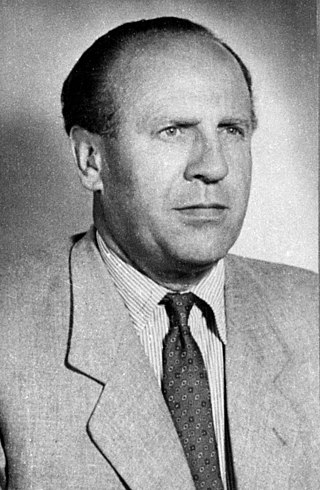
Oskar Schindler was a German industrialist, humanitarian, and member of the Nazi Party who is credited with saving the lives of 1,200 Jews during the Holocaust by employing them in his enamelware and ammunitions factories in occupied Poland and the Protectorate of Bohemia and Moravia. He is the subject of the 1982 novel Schindler's Ark and its 1993 film adaptation, Schindler's List, which reflect his life as an opportunist initially motivated by profit who came to show extraordinary initiative, tenacity, courage, and dedication in saving his Jewish employees' lives.

Camp Westerbork, also known as Westerbork transit camp, was a Nazi transit camp in the province of Drenthe in the Northeastern Netherlands, during World War II. It was located in the municipality of Westerbork, current-day Midden-Drenthe. Camp Westerbork was used as a staging location for sending Jews, Sinti and Roma to concentration camps elsewhere.

Jozef Gašpar Tiso was a Slovak politician and Catholic priest who served as president of the First Slovak Republic, a client state of Nazi Germany during World War II, from 1939 to 1945. In 1947, after the war, he was executed for treason in Bratislava.
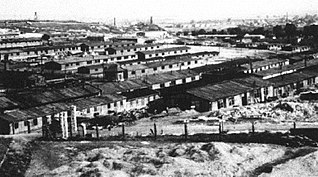
Płaszów or Kraków-Płaszów was a Nazi concentration camp operated by the SS in Płaszów, a southern suburb of Kraków, in the General Governorate of German-occupied Poland. Most of the prisoners were Polish Jews who were targeted for destruction by Nazi Germany during the Holocaust. Many prisoners died because of executions, forced labor, and the poor conditions in the camp. The camp was evacuated in January 1945, before the Red Army's liberation of the area on 20 January.
This is a selected bibliography and other resources for The Holocaust, including prominent primary sources, historical studies, notable survivor accounts and autobiographies, as well as other documentation and further hypotheses.

Drancy internment camp was an assembly and detention camp for confining Jews who were later deported to the extermination camps during the German occupation of France during World War II. Originally conceived and built as a modernist urban community under the name La Cité de la Muette, it was located in Drancy, a northeastern suburb of Paris, France.

Operation Reinhard in Kraków, often referred to by its original codename in German as Aktion Krakau, was a major 1942 German Nazi operation against the Jews of Kraków, Poland. It was headed by SS and Police Leader Julian Scherner from the Waffen-SS. The roundup was part of the countrywide Aktion Reinhard, the mass murder of Polish Jews in the so-called General Government under the command of SS und Polizeiführer Odilo Globočnik.
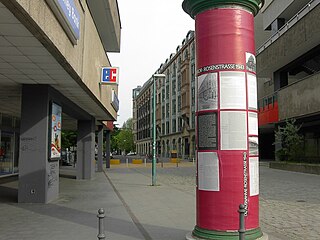
Fabrikaktion is the term for the last major roundup of Jews for deportation from Berlin, which began on 27 February 1943, and ended about a week later. Most of the remaining Jews were working at Berlin plants or for the Jewish welfare organization. The term Fabrikaktion was coined by survivors after World War II; the Gestapo had designated the plan Große Fabrik-Aktion. While the plan was not restricted to Berlin, it later became most notable for catalyzing the Rosenstrasse protest, the only mass public demonstration of German citizens which contested the Nazi government's deportation of the Jews.
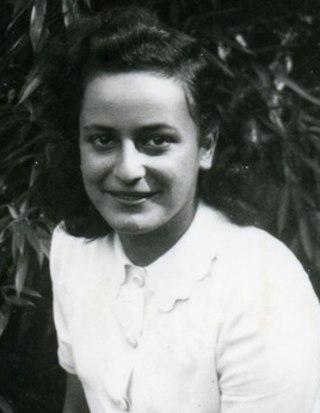
Hélène Berr was a French woman of Jewish ancestry and faith, who documented her life in a diary during the time of Nazi occupation of France. In France she is considered to be a "French Anne Frank". She died from typhus during an epidemic of the disease in Bergen-Belsen concentration camp that also killed Anne Frank and her sister Margot.

The Radom Ghetto was a Nazi ghetto set up in March 1941 in the city of Radom during the Nazi occupation of Poland, for the purpose of persecution and exploitation of Polish Jews. It was closed off from the outside officially in April 1941. A year and a half later, the liquidation of the ghetto began in August 1942, and ended in July 1944, with approximately 30,000–32,000 victims deported aboard Holocaust trains to their deaths at the Treblinka extermination camp.

The Holocaust in Hungary was the dispossession, deportation, and systematic murder of more than half of the Hungarian Jews, primarily after the German occupation of Hungary in March 1944.

The Holocaust in the Netherlands was organized by Nazi Germany in occupied Netherlands as part of the Holocaust across Europe during the Second World War. The Nazi occupation in 1940 immediately began disrupting the norms of Dutch society, separating Dutch Jews in multiple ways from the general Dutch population. The Nazis used existing Dutch civil administration as well as the Dutch Jewish Council "as an invaluable means to their end".

The Working Group was an underground Jewish organization in the Axis-aligned Slovak State during World War II. Led by Gisi Fleischmann and Rabbi Michael Dov Weissmandl, the Working Group rescued Jews from the Holocaust by gathering and disseminating information on the Holocaust in Poland, bribing and negotiating with German and Slovak officials, and smuggling valuables to Jews deported to Poland.

The Holocaust in Slovakia was the systematic dispossession, deportation, and murder of Jews in the Slovak Republic, a client state of Nazi Germany, during World War II. Out of 89,000 Jews in the country in 1940, an estimated 69,000 were murdered in the Holocaust.
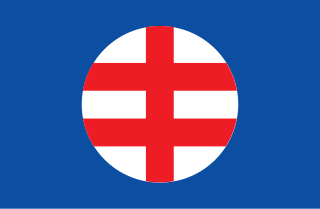
The Hlinka Guard Emergency Divisions or Flying Squads of the Hlinka Guard were Slovak paramilitary formations set up to counter the August 1944 Slovak National Uprising. They are best known for the role they played in murdering Jews, Romani people, and actual or suspected Slovak partisans in conjunction with Einsatzgruppe H, especially for their participation in the Kremnička massacre.

The Holocaust in the Sudetenland resulted in the flight, dispossession, deportation and ultimately death of many of the 24,505 Jews living in the Reichsgau Sudetenland, an administrative region of Nazi Germany established from former Czechoslovak territory annexed after the October 1938 Munich Agreement. Due to harassment and violence, including during Kristallnacht, ninety percent of the Jews had already left the Sudetenland by mid-1939. The remaining Jews were subject to property confiscation and eventually deportation. During the later years of the war, tens of thousands of Jews and non-Jews were forced laborers in a network of concentration camps in the Sudetenland.

The first mass transport of Jews to Auschwitz concentration camp departed from Poprad transit camp in the Slovak Republic on 25 March 1942 and arrived at its destination on 26 March. It was the beginning of systematic deportation of Jews to Auschwitz concentration camp by the Reich Security Main Office and also the first transport of Jews from Slovakia.
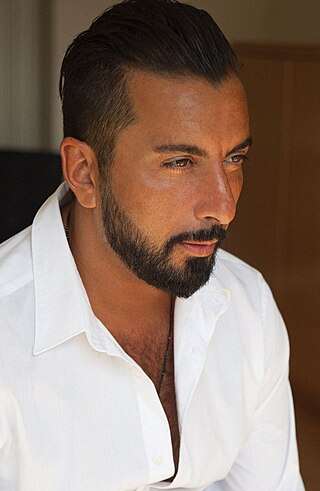
Danny A. Abeckaser is an Israeli-born American actor, director and filmmaker.

Linda Breder was a Slovak Holocaust survivor. During World War II, Breder was among the nearly 1,000 teenage girls and unmarried young women deported on the first official transport of Jews to Auschwitz. Very few of the girls on this first transport – or any of the other early transports – survived the more than three years until the end of the war. In Auschwitz, Breder worked as part of the Kanada Kommando, responsible for collecting the stolen belongings of prisoners, mostly Jews who had been murdered in the gas chambers on arrival.

















